Intelligent Cockpit Domain Control Unit (DCU) and Head Unit Dismantling Report, 2023 (1)
Dismantling of Head Unit and Cockpit Domain Control Unit (DCU) of NIO, Toyota and Great Wall Motor
The report highlights the dismantling of Toyota’s MT2712-based head unit, Fisker’s Intel A2960-based head unit, Great Wall Motor’s Qualcomm 8155-based head unit and NIO ET7 cockpit DCU, and estimates and analyzes Great Wall Motor’s head unit and NIO’s DCU.
This article takes NIO ET7 cockpit DCU we dismantle as an example.
"In terms of hardware, NIO ET7 packs a second-generation digital cockpit that is equipped with a 12.8-inch AMOLED center console screen, a 10.2-inch HDR digital cluster, a 6.6-inch HDR multi-function control screen in the rear row, and an enhanced head-up display (HUD) system. It runs the Banyan IVI System based on Qualcomm Snapdragon 8155 chip. The head unit carries the 16GB+256GB memory portfolio, supports multiple unlock methods like UWB digital key, and is equipped with some remote functions and AR-HUD system, as well as a built-in driving recorder.”
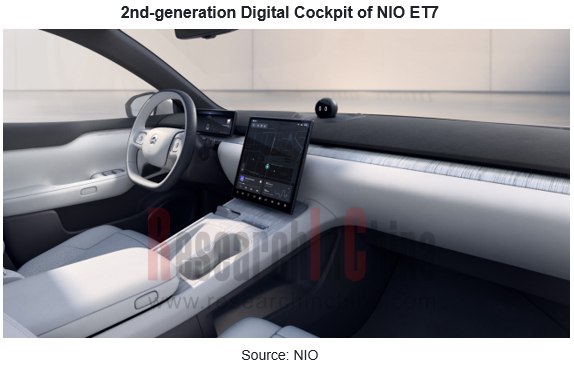
Appearance and interfaces
NIO ET7 bears NIO’s second-generation cockpit DCU. Compared with the first-generation, the SoC chip of the second-generation cockpit DCU is changed from Nvidia Parker to Qualcomm SA8155P. The second-generation cockpit DCU will be applied to all NIO models.
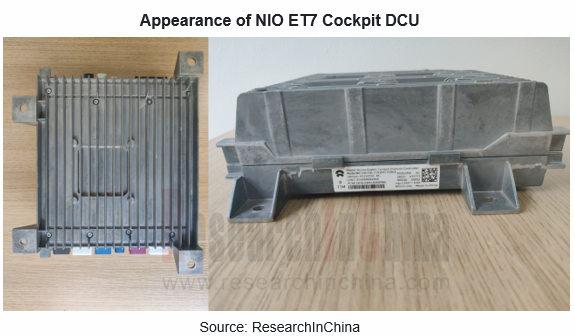
The interfaces on the lower side of the bottom view in the above picture, from left to right, are: center console display and rear display connector, cluster and HUD connector, 1 USB3.0 connector, 2 USB connectors, and 2 Ethernet connectors, and inside the white plastic sleeves are WiFi and Bluetooth antennas.
NIO ET7 cockpit DCU has a distinctive appearance. The heat sink on the backboard is recessed in the middle in a bid to be close to the SA8155P module that generates the most heat.
The interior of the housing of NIO ET7 cockpit DCU is relatively complicated. The inner layer of the housing is also embedded with a spongy material that absorbs impact. The holes on the right correspond to the two large capacitors on the PCB. The two capacitors are relatively high with ultra-large capacity up to 25 farads. They function as a battery. It is presumed that the two capacitors are added in the consideration of the fact that sometimes when a vehicle is parked for too long, the battery runs out of power but some wireless remote vehicle control functions still need to work.
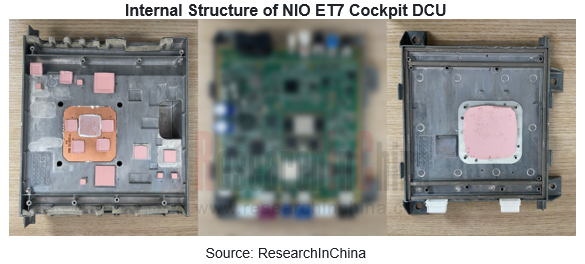
Unlike most vehicle PCBs with connectors on one side, NIO’s cockpit DCU PCB has connectors on both sides.
CPU and memory chip
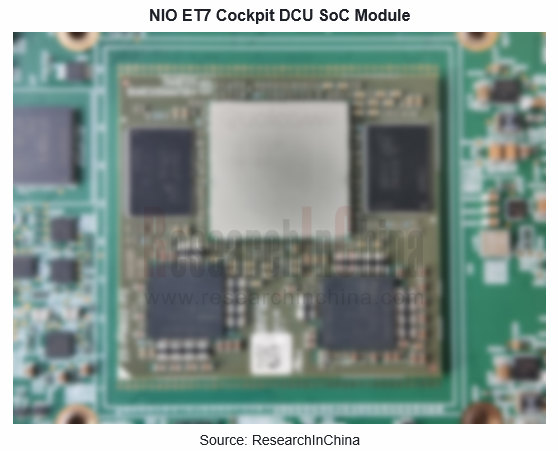
In the center of the DCU PCB lies the SoC module which accommodates one SA8155P chip, two PMM8155AU power management chips and two Micron memory chips.
Next to the capacitor side of the SoC module is a 256GB UFS 2.1 memory chip from Samsung. UFS 2.1 features working voltage of 1.8/3.3V, G3 2Lane interfaces, and temperature range of -40℃~105℃. The estimated price range of this chip is USD15-20.
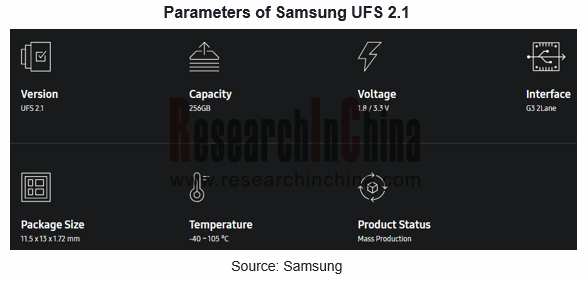
Ethernet switch
The relatively big chip next to the MCU and the capacitor is an 88EA6321 Ethernet switch provided by Marvell.
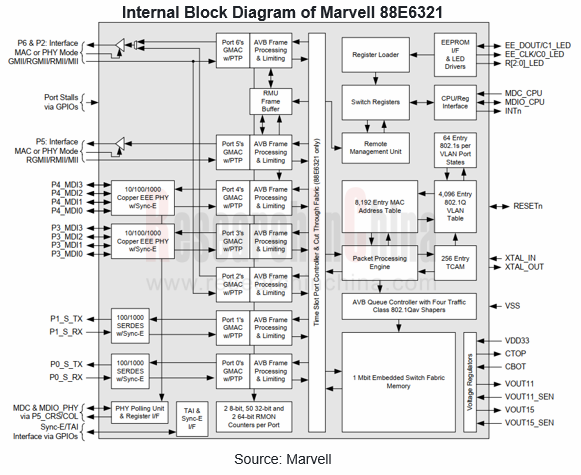
The picture above shows the internal framework of Marvell 88E6321, a 7-port Ethernet switch for automotive EAVB. 88E6321 carries two IEEE 10/100/1000BASE-T/TX/T interfaces (corresponding to RJ45, namely, a conventional registered jack as often said), two RGMII/xMII interfaces or one GMII interface, two SGMII/SerDes interfaces, and one RGMII/xMII interface. The MII (medium-independent interface) is a standard interface connecting the MAC and the PHY. It is an IEEE-802.3 defined Ethernet industry standard.
10/100/1000BASE-T/TX/T refers to the transmission cable. Port 2, 5 and 6 can be configured as MAC or PHY mode, and all support RGMII/RMII/MII. Port 2 and 6 also support GMII. Port 3 and 4 support 10M/100M/1000M adaptive Ethernet interfaces. Port 0 and 1 support 100M/1000M optical ports (SFP). 88E6321 launched around 2014 is an old product that does not support the latest TSN. It is not an automotive Ethernet switch in the strict sense, and is currently sold at a markdown price of about USD10-15. (MII refers to Medium Independent Interface; RMII, Reduced MII; SMII, Serial MII; GMII, Giga MII)
Video I/O
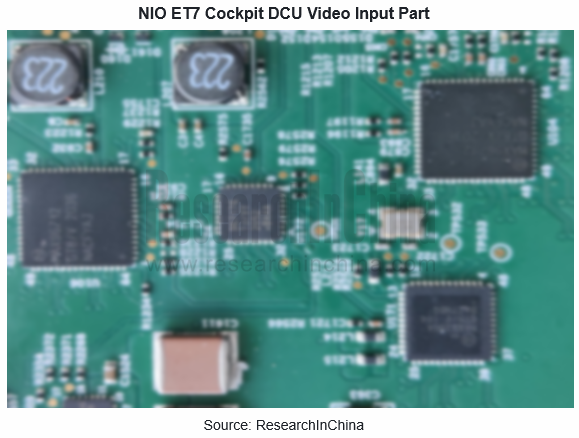
The picture above is the video input part of ET7 cockpit DCU. It uses a total of 4 serializer/deserializer chips (all from MAXIM, a company acquired by ADI), including two MAX96712 deserializer chips, one of which corresponds to the inputs of the four 3-megapixel surround-view cameras of NIO ET7.
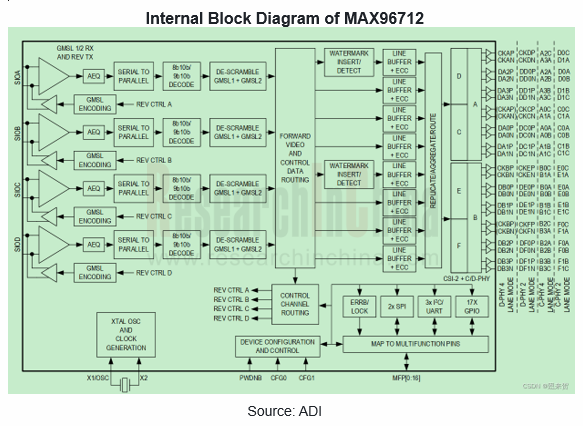
The picture above is the internal framework of MAX96712 which enables MIPI CSI-2 4Lane reception and delivers the maximum bandwidth of 6Gbps, that is, it can connect four 4-megapixel cameras and outputs two channels. It is currently the highest bandwidth deserializer chip priced at about USD15-20.
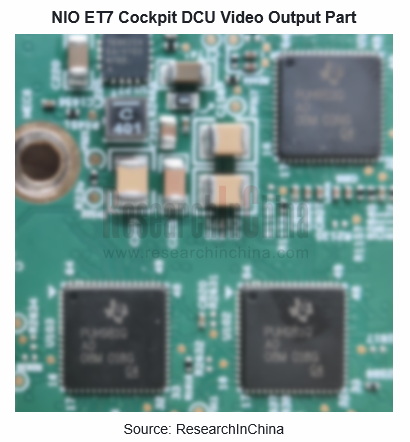
The video output part of NIO’s head unit in the picture above uses three TI serializer chips and video format conversion. All the three serializer chips require signing a non-disclosure agreement (NDA). SA8155 can support a variety of up to 24-megapixel display configuration interfaces (e.g., at most three 4K60 displays) via three native displays. It supports two 4-lane DSI D-PHY at 2.5 Gbps per lane or two 3-trio C-PHY at 5.7 Gbps per lane, an integrated display port shared with USB 3.1 Gen 2 at 8.1 Gbps/lane. It allows for 4K60 display ports concurrency and USB 3.0 operation, and enables other display single interfaces (DDSI) by using DisplayPort multi-stream transport (MST) and dual displays.
Back of PCB
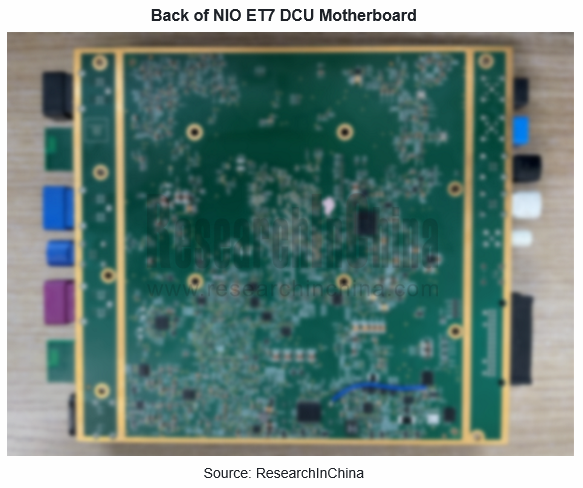
There is a flying line on the front and back of the PCB. The flying line on the back is very obvious, about 4.5cm in length, which means that the PCB needs hand soldering in the end. This will affect efficiency and quality stability, and will also push up the overall cost of the cockpit DCU.
Intelligent Vehicle Cockpit-driving Integration (Cockpit-driving-parking) Industry Report, 2024
At present, EEA is developing from the distributed type to domain centralization and cross-domain fusion. The trend for internal and external integration of domain controllers, especially the integrat...
Global and China Automotive Operating System (OS) Industry Report, 2023-2024
Chinese operating systems start to work hard In 2023, Chinese providers such as Huawei, Banma Zhixing, Xiaomi, and NIO made efforts in operating system market, launched different versions with competi...
Automotive RISC-V Chip Industry Research Report, 2024
Automotive RISC-V Research: Customized chips may become the future trend, and RISC-V will challenge ARM
What is RISC-V?Reduced Instruction Set Computing - Five (RISC-V) is an open standard instructio...
Passenger Car CTP (Cell to Pack), CTC (Cell To Chassis) and CTB (Cell to Body) Integrated Battery Industry Report, 2024
Passenger Car CTP, CTC and CTB Integrated Battery Industry Report, 2024 released by ResearchInChina summarizes and studies the status quo of CTP (Cell to Pack), CTC (Cell To Chassis) and CTB (Cell to ...
Software-defined Vehicle Research Report, 2023-2024 - Industry Panorama and Strategy
1. How to build intelligent driving software-defined vehicle (SDV) architecture?
The autonomous driving intelligent platform can be roughly divided into four parts from the bottom up: hardware platf...
Automotive DMS/OMS (Driver/Occupant Monitoring System) Research Report, 2023-2024
In-cabin Monitoring study: installation rate increases by 81.3% in first ten months of 2023, what are the driving factors?
ResearchInChina released "Automotive DMS/OMS (Driver/Occupant Monitoring Sys...
Automotive Functional Safety and Safety Of The Intended Functionality (SOTIF) Research Report, 2024
As intelligent connected vehicles boom, the change in automotive EEA has been accelerated, and the risks caused by electronic and electrical failures have become ever higher. As a result, functional s...
Autonomous Driving Map Industry Report,2024
As the supervision of HD map qualifications tightens, issues such as map collection cost, update frequency, and coverage stand out. Amid the boom of urban NOA, the "lightweight map" intelligent drivin...
Automotive Vision Industry Research Report, 2023
From January to September 2023, 48.172 million cameras were installed in new cars in China, a like-on-like jump of 34.1%, including:
9.209 million front view cameras, up 33.0%; 3.875 million side vi...
Automotive Voice Industry Report, 2023-2024
The automotive voice interaction market is characterized by the following:
1. In OEM market, 46 brands install automotive voice as a standard configuration in 2023.
From 2019 to the first nine month...
Two-wheeler Intelligence and Industry Chain Research Report, 2023
In recent years, two-wheelers have headed in the direction of intelligent connection and intelligent driving, which has been accompanied by consumption upgrade, and mature applications of big data, ar...
Commercial Vehicle Telematics Industry Report, 2023-2024
The market tends to be more concentrated in leading companies in terms of hardware.
The commercial vehicle telematics industry chain covers several key links such as OEMs, operators, terminal device ...
Automotive Camera Tier2 Suppliers Research Report, 2023
1. Automotive lens companies: "camera module segment + emerging suppliers" facilitates the rise of Chinese products.
In 2023, automotive lens companies still maintain a three-echelon pattern. The fir...
China Passenger Car Navigate on Autopilot (NOA) Industry Report, 2023
Intelligent driving is evolving from L2 to L2+ and L2++, and Navigate on Autopilot (NOA) has become a layout focus in the industry. How is NOA advancing at present? What are hotspots in the market? Wh...
Automotive Telematics Service Providers (TSP) and Application Services Research Report, 2023-2024
From January to September 2023, the penetration of telematics in passenger cars in China hit 77.6%, up 12.8 percentage points from the prior-year period. The rising penetration of telematics provides ...
Passenger Car Intelligent Chassis and Chassis Domain Controller Research Report, 2023
Passenger Car Intelligent Chassis and Chassis Domain Controller Research Report, 2023, released by ResearchInChina combs through three integration trends of brake-by-wire, steer-by-wire, and active su...
Automotive Smart Cockpit Design Trend Report, 2023
As the most intuitive window to experience automotive intelligent technology, intelligent cockpit is steadily moving towards the deep end of “intelligence”, and automakers have worked to deploy intell...
China Automotive Multimodal Interaction Development Research Report, 2023
China Automotive Multimodal Interaction Development Research Report, 2023 released by ResearchInChina combs through the interaction modes of mainstream cockpits, the application of interaction modes i...